- Nom Nom Dog Food Subscription Review - November 7, 2023
- 7 Best Dog Bed Ideas For Great Dane (DIY Options) - July 16, 2022
- Top 5 Rated Best Non-Prescription Diabetic Dog Food - July 15, 2022
Your puppy’s first night home is a time of anxious excitement that you try to tamp down. The puppy has to sleep, after all! Your puppy also needs some time to adjust to the change in environment. The first day and night with your puppy is a balance between gentle understanding and firm guidance as you lay the foundation of your relationship with your new dog.
Every puppy is an individual, but they have a lot in common as well. Puppies want security, enrichment, care, and consistency. They also have many needs like frequent meals, extra trips to the backyard for potty, and periods of exercise to burn off some energy.
This guide will help you put a plan in place for the first night with your brand new puppy.
Troubleshooting Puppy’s First Day
The puppy is finally in your home! It seemed like forever to wait but the day has arrived. You’ve taken time off work to get your puppy comfy in your home. You also have some toys on hand. The food is ready to be eaten and you’ve picked out a perfect spot for your puppy to sleep.
Then something goes wrong. The puppy is crying and won’t sleep. She is afraid. She is so rambunctious that she’s all over the place. He peed twice on the floor immediately.
Hang in there! This is an adjustment period. In the hopes of preventing this kind of temporary disaster, here are some common new puppy problems and how to deal with them.
Puppy Crying
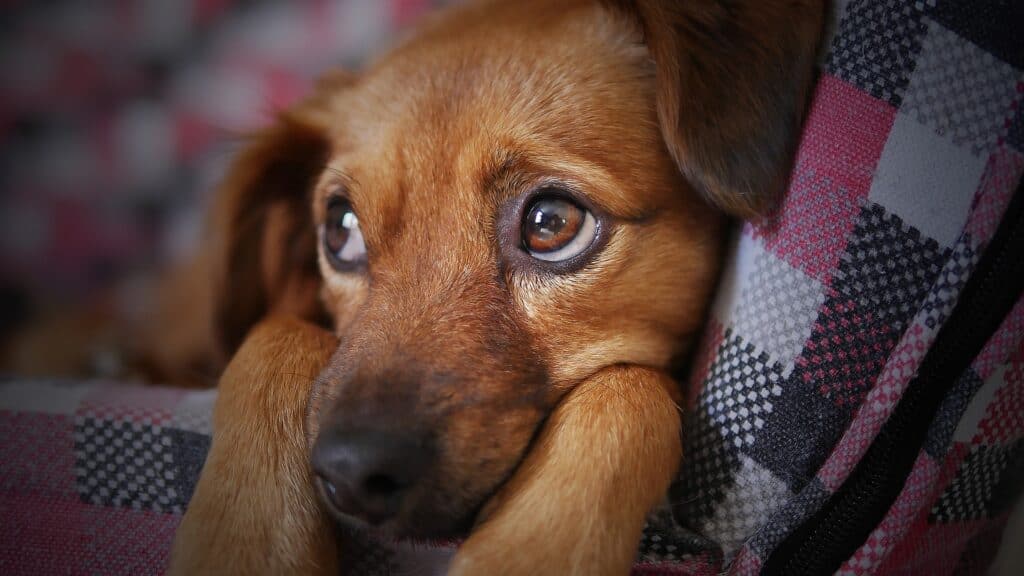
This is a tough one and requires some willpower. Like with a baby, you will have to let your puppy cry sometimes. How do you know when to comfort him and when to let him soothe himself?
Your absolute best bet is to be preventative. Your puppy’s bedtime routine should result in satisfaction of his needs. Puppies like to sleep a lot, so if you follow some steps for the bedtime routine you’ll set yourself up for success.
The Perfect Puppy Bedtime Routine
This is my FPPC plan! Forgive me, I love acronyms. Start working through the steps at a comfortable pace around 2 hours before your puppy’s actual bed time. Also, be consistent with your timeline. Your puppy will sleep easier if his body adjusts to a schedule.
Feed
Feed your puppy his last meal of the day around 2 hours before bedtime. I like to wet the puppy’s food with warm water for the first few weeks. If you do this, be sure to phase in dry food by mixing the two. You don’t want your puppy to refuse to eat dry food when the time comes.
I pay attention to the puppy’s teeth and whether or not he is a vacuum eater. Once the puppy is chewing toys with earnest, I add dry food in slowly increasing quantities. Just pour the water over the portion you want to wet, let it sit for a few minutes, and then toss in some fresh dry food.
Puppies that eat too fast can benefit from wet food. It either slows them down or at least makes the sudden load of food in their bellies easier on them.
Now your puppy is fed. Let his food settle a few minutes and then head out to play.
Play
You can start play in the house and then transition to outside as a lead up for potty business. I find ball toys to be super helpful with tiring puppies out. They absolutely love them. They also have a hard time getting their small mouths around tennis size balls, and the struggling wears them out.
If your puppy loves a special toy, by all means use that for pre-bedtime play. Go ahead and let your puppy get really riled up and blow off some steam.
Try to get a short walk in as well. Even bringing your dog up and down the street or around your block provides some mental stimulation. There are new things to see and smell. Your puppy also has to obey you to some extent on the walk. Toss in a few simple commands to make your puppy sit and wait at points during your play.
This way, your little dog gets mental and physical stimulation.
If you can manage it, run around with your puppy or throw the ball fast enough to get them running flat-out.
Set aside 30 to 45 minutes for pre-bedtime playtime and a potty break.
Potty
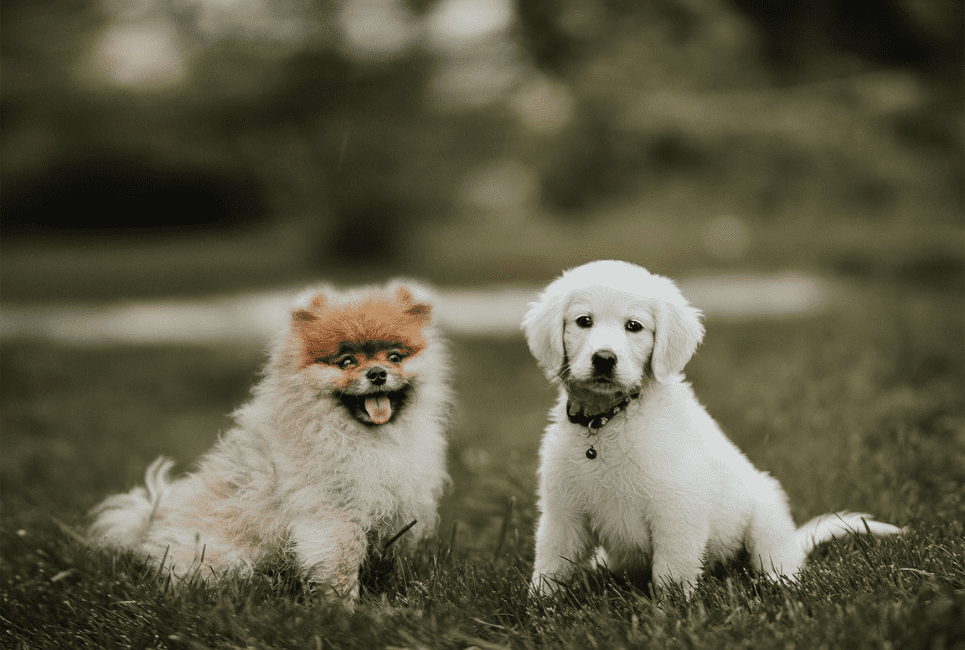
Presumably, your puppy will eliminate during playtime. Make sure you see both movements. It’s a long time overnight and your puppy can’t hold it for very long.
If he just won’t go, come back inside and try again in 5 to 10 minutes.
Sometimes puppies cry during the night because they need to relieve themselves. You may have to get up a few times to let your new puppy outside during your first few days together. I suggest that you set an alarm rather than let your puppy’s whimpering wake you up.
Gradually lengthen the time between alarms so your puppy gets used to holding it during the night.
The closer to bed time your puppy eliminates, the longer he can sleep undisturbed.
Cuddle
I know that some of you don’t let your dogs on the furniture. While I think the sofa is a great combination cuddle spot and playpen (most puppies won’t jump down on their own right away), you can also get down on the floor to cuddle your puppy.
Either way, spend some time before bed holding and petting your dog. Be calm and let your energy communicate to the puppy that it’s bedtime. If you’re lucky, they’ll fall asleep on their own.
Once they’re asleep, transfer them gently to their crate. If you can keep the lights off while you do this, it’s an even more seamless transition.
If you can’t do this, try to settle your puppy by dimming the lights and giving her a chew toy to fiddle with. Remove any toys that stimulate them and encourage cozy blankets and relaxing. Invite your dog to lay near your feet while you do the dishes or some other stationary chore if you need to stay on the go before bedtime.
Your sleepy puppy is going to be ready for bed in no time.
Puppy Is Biting
Puppies are sort of like adorable little land sharks. Their teeth are so sharp! Puppies explore the world with their mouths, but you can encourage some polite behavior.
If your puppy bites you too hard, use a command like ‘ow!’ The more you can make your sound like a puppy yelp, the better. Don’t go too overboard though. You don’t want your puppy to decide it’s fun to bite you because you squeal and carry on.
After you indicate your displeasure, make your puppy sit or obey you in some way. If he shakes, ask him to. Whatever trick he has learned, prompt him to do it. This doesn’t always work with rambunctious puppies, but you should keep trying.
Finally, when you have your puppy’s attention, distract him with something. Encourage play with a chew toy. Alternately, you can simply offer the chew toy whenever the puppy bites you in play.
Your puppy may also want to chew on you. Use the same tactics to encourage toys for teething.
Chewing brings us to the subject of puppy proofing.
Puppy is Destructive
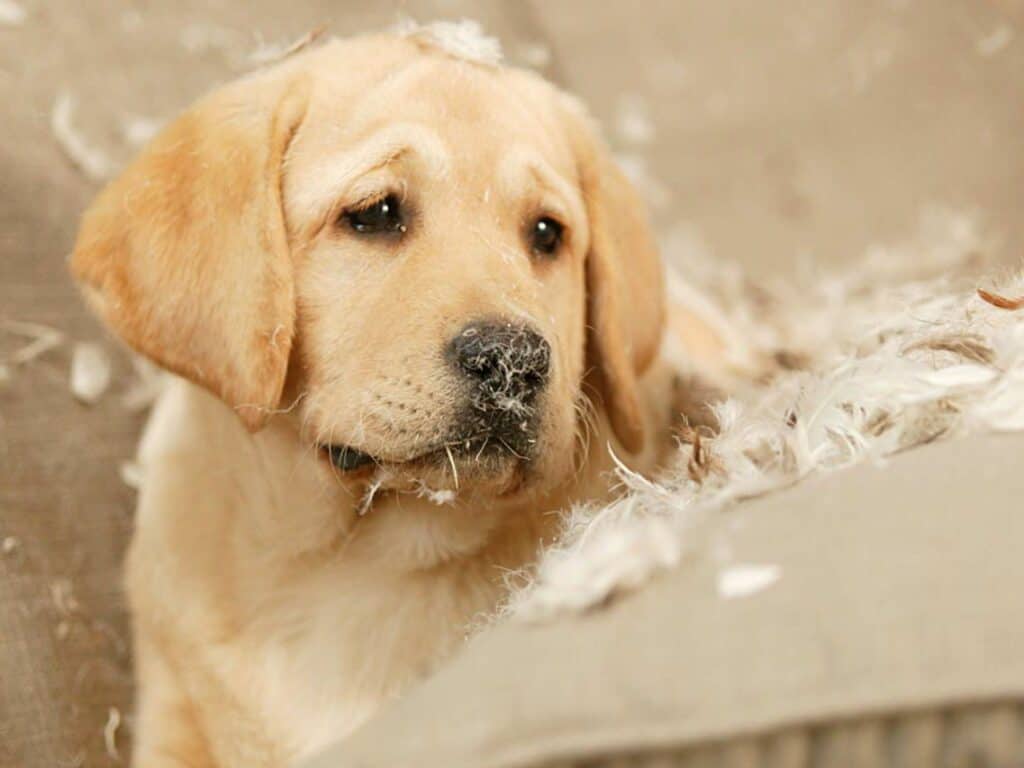
Most puppies are destructive to some extent. You have to puppy proof your home to stay one step ahead of your new dog. Puppy proofing is also important because your dog could injure himself on common household items.
Scout Knows that puppy proofing is an important concern for dog owners, so we covered that topic in great detail in a separate post.
Basically, you want to read that post for our comprehensive checklist of things to look at in your home. After you go through the checklist you may need to pick up some of the product suggestions to help you out. There are cord protectors on the market or you can even make your own with some split tubing. You may also want to tuck away things like the cord to your blinds.
Finally, get down on your puppy’s level and go through your home again. Do you see anything enticing? Block interesting, off-limits areas and use bitter apple spray on things you can’t move to prevent chewing. Baby gates and puppy pens can come in handy so don’t be afraid to stock up on some.
Puppy Is Jumping
Puppies jump when they’re excited or overstimulated. Try to bring the energy in the situation down if your puppy is getting too wild. Choose a command like ‘down’ or ‘off’ and use it consistently. Like with biting, if you can prompt your puppy to complete a trick or task for you, that can help establish your control over the situation.
Ask your friends and family to use the same stop command as you do to tell your puppy to stop jumping. If they’re on board, they can help you train your puppy. If they aren’t, they can actually set back your training.
You can also identify when your puppy jumps and use this information to modify your training. Does your puppy get too excited when you come home? Adjust your greeting behavior and see if that helps. You should greet your dog calmly or even ignore the puppy until you’re in the door. Ask the dog to sit before saying hello. Some dogs get excited at feeding time, and you can ask your dog to sit and stay until you give the ok to eat.
Even if your puppy can’t exactly do these things right off the bat, keep trying. Remember that consistency is really the key. Keep treats on hand to reinforce all of these behaviors and praise your dog liberally when he does what you want. Eventually your puppy is going to get it.
Potty Training Problems
Potty training your puppy also calls for consistency. We went in-depth about potty training a puppy in a recent post, so check that out if this is a trouble spot for you.
Essentially, you want to take your puppy out regularly and never leave it alone for longer than 4 hours for the first few weeks. See if a friend or dog walker can help you. If you can run home during lunch, this can also work out. When your puppy first arrives, it may need to pee every 2 hours. You have to make some adjustments in your routine while your puppy’s body develops.
If you use training pads, try to only use one or two in the same area. This helps to teach your puppy that there is a right and wrong place to go. As you continue, move the location of the pad closer and closer to the door. You can even bring it outside with you if you need to.
Try your best not to end outside time as soon as your dog goes. When it’s raining and cold this isn’t always possible. But most of the time, give your dog a few minutes to keep exploring. If you always run inside as soon as they go, your puppy might try to put off going to stay outside longer.
Gear To Have The First Day And Night With Your Puppy
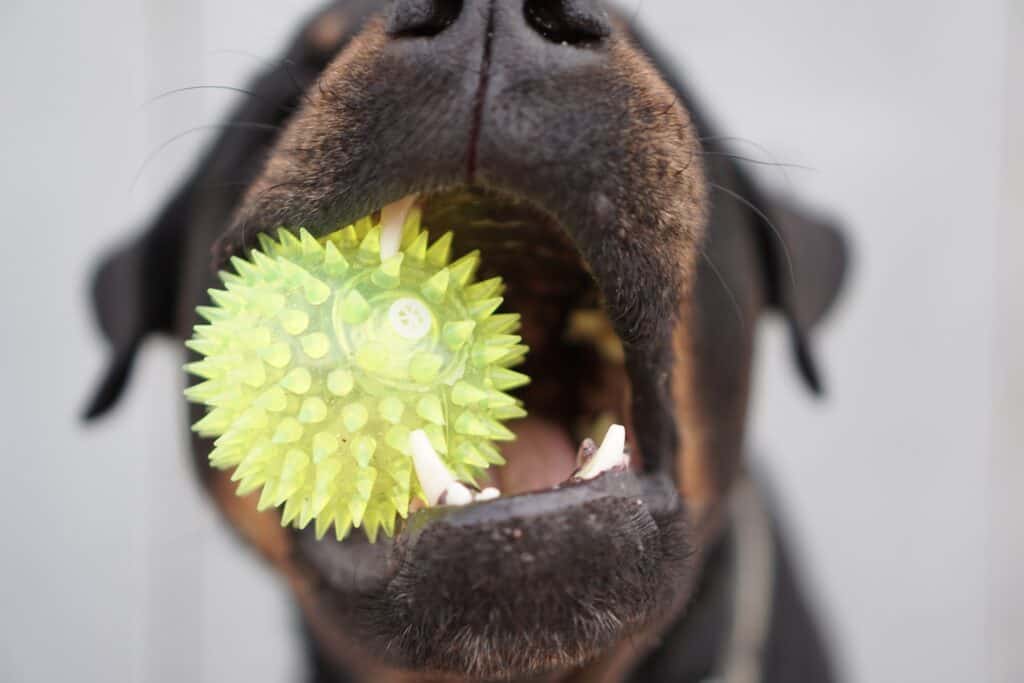
Ok, so we’ve done some troubleshooting of common first night with puppy problems. Now we’re on to general must haves to ensure a successful first night with your puppy. While you can buy all kinds of accessories for your puppy from clothes to fountain water dishes, here are a few things it will be hard to do without.
- Dog Carrier
- Dog Bed
- Puppy Training Pads
- Cleaning Products For Accidents
- A Collar Or Harness
- A Leash
- Blankets
- Dog Food Bowl
Find detailed suggestions on brands and products in each of these categories at our guide to gear you need before you get a dog. Next, on to toys, which get their own mini list.
Toys
- Balls
- Tossing Or Fetch Toy
- An Interactive Toy
- A Soft Toy
- A Chew or Teething Toy
Toys that fall into these categories provide varied enrichment for your puppy. It’s a good idea to have a couple of each so you can rotate toys in and out. It’s also necessary to replace toys fairly often. As your puppy plays with the toys, he will wear them down.
Establish A Daily Routine For Your Puppy
Setting up a routine for the rest of your day is also good for your puppy. Feed your puppy around the same time every day. I sometimes offer a little bit extra while I’m eating, so the dog can share in the social experience. Be mindful to only use treat sized portions if you do this.
Basically, though, dogs should eat at the same time each day. They should go outside around the same times as well. For instance, you probably take your puppy out as soon as you get home.
Your dog is crated at certain times of the day, like when you are away or at work. Your walk probably happens in the evening, which becomes a routine for your puppy.
It’s actually fairly easy to set a daytime schedule for your dog because most people are on a schedule themselves.
Tips For A Successful First Night
Now you have some guidance and a routine to follow to prepare your puppy for bedtime and how to get a puppy to sleep. Use these techniques to signal to your puppy that it’s night time.
If you’re still having problems, try extending the play time or adjusting your puppy’s final feeding time. Some dogs like to have some safe toys in their crate overnight so they can soothe themselves if they can’t sleep. Use your best judgment about whether this is safe, and which toys are ok to provide to your dog unsupervised.
Your daytime routine is also important. It will set you up for your bedtime routine because your dog will know what to expect. Sticking to a schedule can also prevent dogs from developing anxiety. Just toss in some novelty here and there and promote healthy socialization.
Puppy proofing is also important. You’ll need some basic toys and supplies to be ready for the first sleepover with your puppy, too.
You’ve got this, though. You’re ready to provide a great home for your new addition. Let us know how it goes and remember to upload a photo to your comment! If you have any other tips and tricks for bringing a new puppy home, let me know. Experienced dog owners is often where the choicest gems of information come from.
Continue reading:
Giving Your Puppy Their First Bath

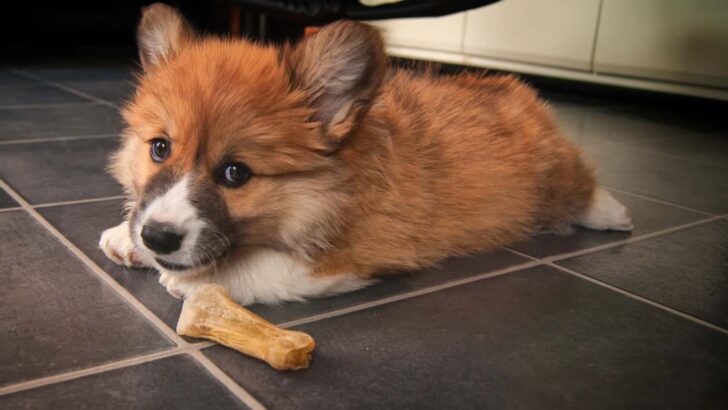

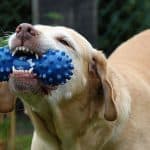

Sam
Friday 8th of April 2022
Great post. Puppies and kittens are most adorable creatures on the planet. It is very important to have some preparation works before we have new family member.